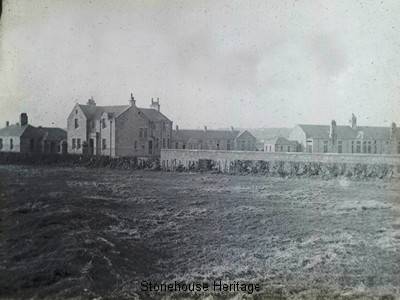Probably the first hospital in the parish was at Spittal House, dating back to at least 1596. During the 17th century the land of Spittal was said to belong to the hospital of Hamilton, St. Thomas Martyr. The word Spittal, Spittel or Spital (Scots) means either a charity hospital or a hospice (shelter for travellers). Some believe a convent was once established at the Spittal, but there is only a little evidence to support this. It is said that travellers sought shelter and refuge on their journey here under the ‘hospitality’ of the convent.
On the 9th January, 1896 Stonehouse,Hospital was officially opened and was originally built as a local authority infectious diseases hospital for the Middle Ward of Lanarkshire c.1896.
This event was marked by a soiree involving the local worthies of the time, and as befits such an occasion it was covered by the Hamilton Advertiser. The following article from the Hamilton Advertiser provides some detail
“On the Friday evening prior to the opening the Parish Councillors interested met in the premises, and were entertained by the committee to a social tea, having previously been shown through the different wards. County Councillor Templeton,
chairman of the sub committee presided and, in a short and appropriate address, said he was pleased to preside over an assembly comprising the County Councillors, Parish Representatives, and the Parish Councillors of Avondale, East Kilbride, Glassford,Stonehouse and Dalserf, along with the architect, the tradesmen, and other officials connected with the building of the hospital. County Councillor Barr, (East Kilbride), in an able speech set forth the merits of the hospital – the pleasure it gave him to see so many taking an interest in it, the careful management and strict supervision exercised by the committee, and hoped that it might prove a great boon to the parishes interested. They had secured the services of an able matron, and he moved a vote of thanks. Mr. R. Smillie, (Larkhall) replied, observing that people thought the reign of angels was past, but they were still occasionally to be found, and more frequently in the wards of a hospital or a similar institution than anywhere else. He was always a great admirer of the fairer sex, because more of their number in all grades of society devoted their lives to alleviate suffering humanity. Miss Stevenson had won a reputation as an efficient nurse second to none, and he hoped she would be long spared to enjoy her position.
The cost (for the new hospital) as stated by the chairman, will be between £5000 and £6000.’ position. On her behalf, and that of the staff, he thanked them for the compliment. There were upward of 50 gentlemen present, including Mr. Dobson,
sanitary inspector; Mr. Stewart, and his assistant; and Dr. McLean, lately appointed medical attendant to the hospital. Mrs. Wilson, the county doctor’s wife, was also present, and inspected the hospital. The cost, as stated by the chair
man, will be between £5000 and £6000.
The original buildings had a simple domestic character with a rather irregular roofline. It later developed as a sanatorium for non‑pulmonary TB. In 1916 a Theatre and X‑ray Block was designed by Gavin Paterson of Hamilton and added to the east of the main buildings. During the Second World War hutted ward blocks were built on the site under the Emergency Medical Scheme. These provided a further fourteen wards, theatre and X‑ray room, garage, stores and nurses’ home. During the Second World War hutted ward blocks were built on the site under the Emergency Medical Scheme. These provided a further fourteen wards, theatre and X‑ray room, garage, stores and nurses’ home. With the inauguration of the National Health Service it continued as an orthopaedic, TB and small general hospital. At the eastern edge of the site, nearest to the town, a former Slaughter House was acquired by the hospital and was latterly used as the building office.
The following pdf files contain newspaper articles and some centenary newlsetters and booklets that give some indication as to the role of the hospital in the community.
Dr Jackson Hospital centenary newsletter may 1996
Nursing certificate 1930 Margaret Parker
Newspaper Article 1973 by Jean leishman
Dr Jackson Hospital centenary newsletter may 1996
Hospital Centenary Thanksgiving Service
Newsletter Hospital centenary programme
Stonehouse New Hospital
The new Stonehouse hospital was opened in May 2004, replacing the former hospital which dated back to 1896. the address of the hospital is Stonehouse Hospital,Strathaven Road,Stonehouse ,Larkhall ,ML9 3NT. Tel: 01698 794 000
The hospital includes 40 inpatient single bedrooms and a full array of communal and more personal day rooms, including a specially designed relaxation (Snoezelen) room.
There is also a personal laundry room, large dining room, accommodation to allow families to stay overnight if needed, staff changing, shower and rest facilities and an enclosed garden space for patients and their families.
The hospital also has outpatient services for the surrounding community including:
- Rheumatology
- Dermatology
- Diabetes
- Neurology
- Surgical
- Gynaecology
- General medicine
- Ear nose and throat
- Optometry
- Podiatry
- Audiology
- Psychiatry
- Addictions
- Dieticians
- Speech and language therapy
- Physiotherapy – including a small gymnasium
- X-ray facilities
[/fusion_builder_column][/fusion_builder_row][/fusion_builder_container]

